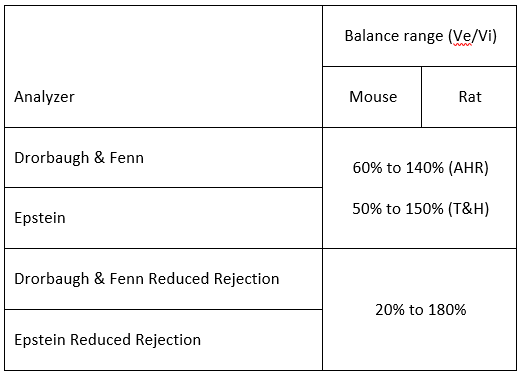Understanding the FinePointe Rinx Parameter
Rinx
The Rinx parameter, or Rejection Index, is the percent of rejected breaths over the logging period.
Algorithm
When a breath is rejected, a rejected breath count is incremented.
Whenever a breath passes all rejection criteria, Rinx is calculated and then the rejected breath count is reset to zero.

Another way to see it is as follows : Every time a valid breath is found, FinePointe goes backwards in time and counts the rejected breaths preceding the valid breath, and computes the Rinx value for this individual breath.
In the example below, the first yellow breath is preceded by 4 rejected breaths (Rinx=80%) and the second yellow breath is preceded by 2 rejected breaths (Rinx=66.67%) :

Reasons to Reject a Breath
- TVb < Minimum TV

- AC Coupled Inspiratory Volume and Expiratory Volume are not within accepted tolerances


- Ti < Minimum Ti

- Ti > 2 x Te
- Pattern does not meet basic definitional criteria:
- PIF must be before PEF,
- Expiration or inspiration is less than a couple samples,
- Rpef, EF50, or Tr could not be computed,
- Conditioning coefficient could not be computed,
- Start of expiration could not be identified on the AC Flow waveform,
- Any unexpected exception occurs during processing.
Rinx in Trend Data Table
If the data is analyzed in breath-mode with a 1-breath interval, the Rinx value in every row indicates how many invalid breaths preceded each valid breath.
For example, Rinx=90% indicates that this valid breath was preceded by 9 invalid breaths.
If the data is analyzed in time-mode, then Rinx has a special treatment!
For other parameters like TVb, the average of all breaths encompassed within the logging interval is computed. However, this is NOT the case for Rinx.
For Rinx, FinePointe will count how many valid breaths are encompassed within the logging interval, and will count how many invalid breaths preceded each valid breath, and then compute the Rinx.
Example Rinx Calculation:
- Breath-based analysis - 1 breath

- Time-based analysis - 2 seconds

The f value is obtained by averaging the f values of the 3 individual breaths: (129.8 + 131.6 + 416.5) / 3 = 226.
The TVb value is obtained by averaging the TVb values of the 3 individual breaths: (2.038 + 2.313 + 0.6272) / 3 = 1.659.
The Rinx value is not obtained by averaging the TVb values of the 3 individual breaths: (50 + 0 + 50 ) / 3 = 33.33 (not 40).
The first breath and the last breath are preceded by one invalid breath. The second breath is not preceded by any invalid breath. So we have 3 valid breaths preceded by a total of 2 invalid breaths : 2 / (2+3) = 40%.
Rinx in Reports
Values reported in the time course report are calculated by averaging all logged lines that fall within the measurement segment.
Reported values will not at all represent the percentage of valid breaths within the measurement segment.
How can I know how many valid breaths are encompassed in my measurement segment ?
Use the Advanced Builder and select the parameter called "N".

The analyzer will report the number of breath included within the average.
Comments
0 comments
Please sign in to leave a comment.